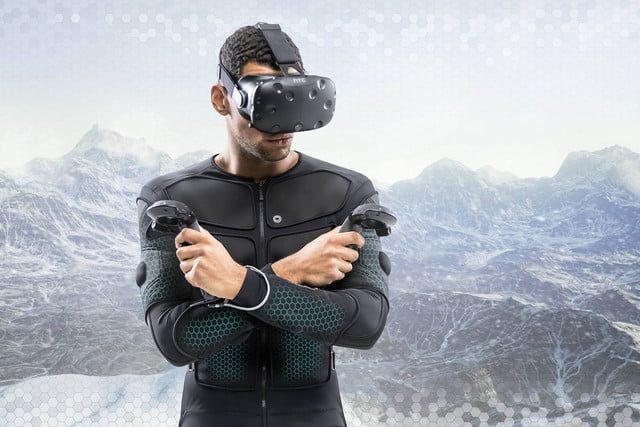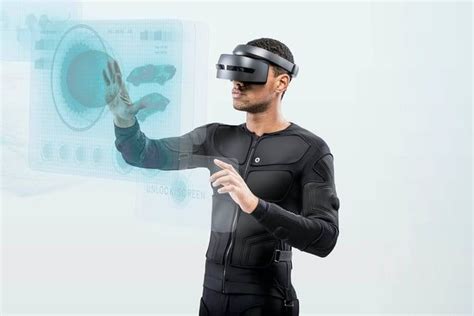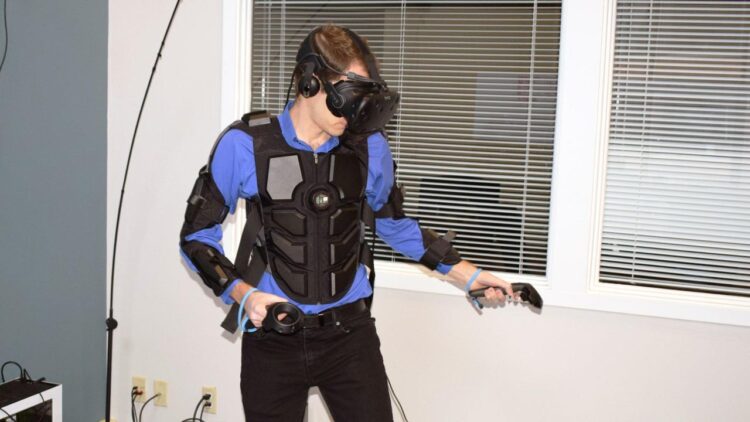For decades, we have interacted with digital worlds through a limited sensory toolkit. Our eyes and ears have been the primary gateways to sprawling fantasy realms, intense sci-fi battlefields, and intricate virtual simulations. We see the explosion and hear the roar of the dragon, but the experience has always been separated by an invisible wall. We are observers, not participants. That wall is now beginning to crumble. The next great leap in digital immersion is here, and it’s not about higher resolutions or more realistic sound—it’s about the sense of touch.
Welcome to the era of the haptic suit, a revolutionary technology that is transforming our relationship with the virtual world. These advanced wearable systems are designed to translate the digital events of a game or simulation into tangible, physical sensations felt across your body. Imagine feeling the subtle patter of rain on your shoulders in a virtual forest, the recoil of a rifle pressed against your chest, or the G-force of a race car cornering at high speed. This is not science fiction; it is the tangible reality that haptic technology is delivering today.
But to label this as simply a “gaming” accessory would be a profound understatement. While gaming is the driving force behind its consumer adoption, the impact of haptic feedback technology extends far beyond entertainment. It is poised to redefine professional training, offer new pathways for medical therapy, and create a deeper sense of connection and presence in the social landscapes of the metaverse. This is the story of how we are learning to feel the digital world, and how in doing so, we are set to change both virtual and physical reality forever.
From Code to Sensation: The Technology of Touch
At its core, a haptic suit is a sophisticated network of actuators and sensors embedded in a wearable vest, suit, or garment. These devices work in concert to convert audio-visual cues and specific developer inputs from a game or application into a wide spectrum of physical feedback. The magic lies in the different methods these suits use to trick our nervous system into feeling virtual events. The industry is currently dominated by three main technological approaches.
- A. Vibrotactile Feedback: The Foundation of Feeling: This is the most widespread and accessible form of haptic technology. It operates on a principle similar to the rumble in a modern game controller or the vibration of a smartphone, but on a much grander and more intricate scale. Suits like the popular bHaptics Tactsuit series are equipped with dozens of individual Eccentric Rotating Mass (ERM) motors, each strategically placed to represent a different part of the torso, arms, or even the face. When you are shot in a game, only the motors in that specific location will activate. This allows for directional and localized feedback, creating a far more immersive experience than a simple controller rumble. While excellent for simulating impacts, textures, and environmental effects like rainfall or explosions, its primary limitation is that it only creates vibrations, not true physical force.
- B. Electro-Tactile Stimulation (EMS): The High-Fidelity Sensation: Pushing the boundaries of realism, electro-tactile stimulation (also known as EMS) represents the next generation of haptic feedback. Instead of using vibrating motors, this technology uses small, safe electrical impulses to directly stimulate the user’s muscles and nerves. Companies like Owo have pioneered this with their “Skin” haptic system, which is a lightweight shirt with embedded electrode pads. By varying the frequency and intensity of these impulses, EMS can replicate a stunningly wide and nuanced range of sensations—from the gentle touch of a breeze or the feeling of an insect crawling on your arm to the sharp sting of a wound or the intense pressure of a punch. Its key advantages are its lightweight form factor and the incredible detail and variety of sensations it can produce.
- C. Force Feedback: Simulating True Resistance: While the previous two technologies simulate sensations on the skin, force feedback aims to simulate actual physical forces acting upon the body. This is the most complex and currently the most niche area of haptic suit technology. These systems often incorporate elements of an exoskeleton or cable-driven mechanisms that can provide physical resistance. For example, a force feedback suit could stop your arm from passing through a virtual wall, make you feel the weight of a virtual shield, or simulate the powerful pushback from a shockwave. High-end, enterprise-level systems like the Teslasuit incorporate elements of force feedback alongside other technologies. While offering the highest level of physical immersion, these systems are currently very expensive, bulky, and primarily used for professional training rather than consumer entertainment.
More Than a Game: The World-Changing Applications

The immersive power of feeling a virtual environment has applications that extend far beyond a gamer’s living room. In high-stakes professional fields, realistic simulation is not a luxury; it’s a necessity.
- A. Redefining Professional and Military Training: For soldiers, first responders, and high-risk industrial workers, training needs to be as realistic as possible to build muscle memory and test decision-making under stress. Haptic suits are a game-changer in this domain. A military simulation can be programmed so that a soldier feels a non-painful but distinct impact on their vest where they were “hit,” reinforcing the importance of using cover. A firefighter-in-training can feel the intense vibrations of a collapsing structure, while a surgeon practicing on a virtual patient can use a force-feedback system to feel the subtle resistance of different tissue types, honing their skills without any risk to a real person.
- B. A New Frontier in Therapy and Rehabilitation: The medical applications for haptics are profound. In physical therapy, a haptic suit can guide a stroke patient’s limbs through prescribed movements, providing sensory feedback that helps to remap neural pathways and accelerate recovery. For amputees being fitted with advanced prosthetic limbs, haptic feedback can be routed from the prosthetic to the suit, allowing them to “feel” the texture and pressure of objects they are holding. Furthermore, it is a powerful tool in mental health, particularly in exposure therapy for patients with PTSD. A veteran can be re-introduced to a triggering virtual environment, while the therapist uses the haptic suit to control the intensity of sensory stimuli, allowing for healing in a safe and controlled manner.
- C. Building Presence in the Metaverse and Social VR: One of the biggest challenges for the metaverse is creating a genuine sense of “presence”—the feeling that you are truly there and interacting with other people, not just their cartoon avatars. Haptics is the key to unlocking this. Imagine a business meeting in VR where you can give a colleague a reassuring pat on the shoulder, or a long-distance family gathering where you can feel the embrace of a loved one’s hug. These simple, tactile interactions create a level of emotional connection and social intimacy that audio-visuals alone can never replicate. Haptic feedback will be what transforms the metaverse from a virtual space into a virtual place.
The Key Players: An Overview of the Haptic Market
As the technology matures, several key companies have emerged, each targeting a different segment of the market.
- bHaptics: Currently the leader in the consumer gaming space. Their Tactsuit line is modular, allowing users to buy a vest, arm sleeves, and even a face cushion separately. Their biggest strength is their growing library of natively supported games, making it one of the easiest “plug-and-play” systems for VR gamers looking to add a new layer of immersion.
- Owo: This company is carving out a name for itself with its cutting-edge electro-tactile technology. Their Owo Skin system is praised for its lightweight, comfortable design and the incredible fidelity of the sensations it can produce. It represents the premium, next-generation choice for enthusiasts who want the most detailed and varied feedback possible.
- Teslasuit: Operating at the highest end of the market, Teslasuit is a full-body platform designed for enterprise, research, and professional training. It combines haptics (both vibrotactile and EMS) with full-body motion capture and biometric sensors that can measure heart rate and stress levels. It is less a gaming accessory and more a complete human-to-digital interface for the most demanding professional simulations.
The Hurdles to a Fully Immersive Future
Despite the incredible progress, several challenges must be overcome for haptic suits to become a mainstream consumer device.
- A. The Content Conundrum: The most advanced haptic suit in the world is useless if the software doesn’t support it. Unlike a display or headphones that work with any content, haptic feedback must be specifically programmed by developers for each individual interaction. While some tools can approximate haptics from audio cues, the best experiences require native integration, a significant investment of time and resources for game studios.
- B. Comfort, Cost, and Convenience: Wearing a second layer of technology brings practical issues. Battery life, heat dissipation, and the overall weight and comfort of the suit are major engineering challenges. Above all, the price remains a significant barrier. While entry-level vests are becoming more accessible, high-end systems can cost thousands of dollars, placing them firmly in the realm of early adopters and commercial clients.
- C. The Uncanny Valley of Touch: Just as computer-generated humans can look “creepy” if they are not quite realistic, poorly implemented haptics can feel strange and unnatural. An effect that doesn’t perfectly match the on-screen action can break a user’s sense of immersion faster than no haptics at all. Perfecting the art of haptic design is a new and complex creative challenge.
The Future is a Feeling

Haptic suit technology is a profound leap forward in our quest for digital immersion. It is the final sensory piece of a puzzle that we have been building for decades. What began as a niche dream for hardcore gamers is now blossoming into a transformative technology with far-reaching implications. From training safer and more effective surgeons to providing new hope for physical therapy patients and fostering deeper human connection across continents, haptics is adding a new, deeply human layer to our digital lives.
The road to a lightweight, affordable, full-body haptic suit in every home is still long. But the revolution is well underway. The boundary between the real and the virtual is becoming less of a solid wall and more of a permeable membrane. Haptic suits are the tools that will allow us to finally step through, not just to see and hear a new reality, but to reach out and truly feel it.












